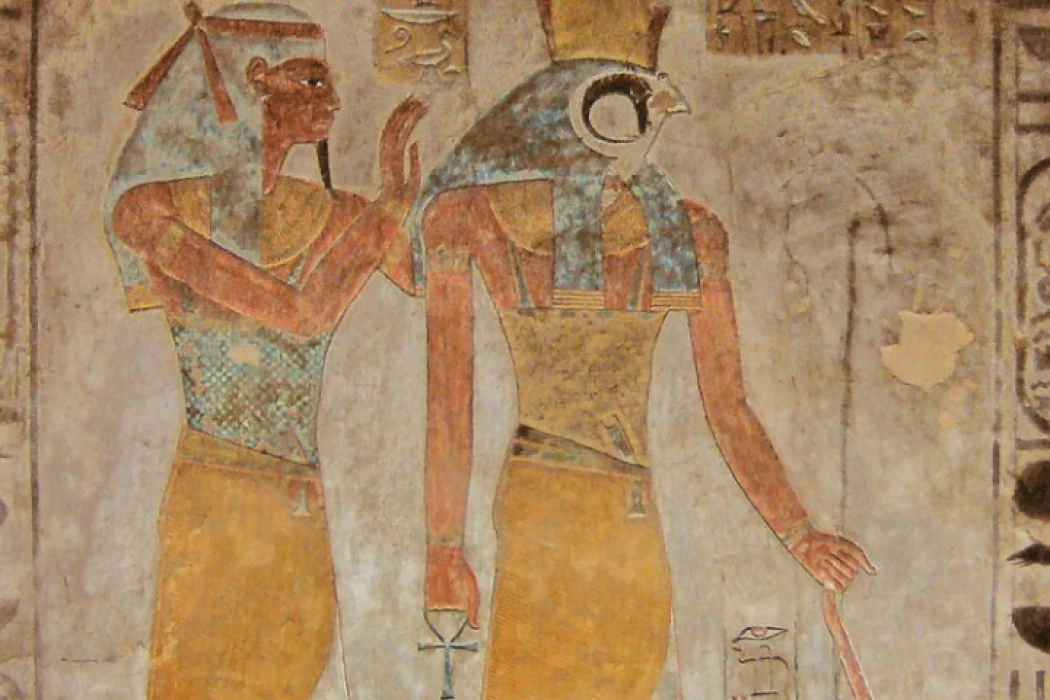
God Geb | God of the Earth
God of the ancient Egyptians
The title of god given to these sanctuaries was not intended to refer to the greatest god, the creator of the universe, but rather to a god specific to a particular aspect of life, such as agriculture, fertility, the Nile, and air, as a form of gratitude and thanks to this sanctuary according to ancient Egyptian belief.
The god "Geb" is one of the gods of the ancient Egyptians. He is the god of the earth and one of the members of the Ennead in Heliopolis. A temple was dedicated to him in the city of "Bata" adjacent to Heliopolis. Geb was worshipped in Memphis and in Kom Ombo, and he was also mentioned on the walls of the Temple of Amun in the city of "Hibis".
Geb is the brother of the sky goddess Nut, and they are both sons of the air god Shu and his wife Tefnut, who was considered the goddess of moisture and water, but archaeologists currently describe her as the goddess of “fire,” as she carries the Eye of Ra (the sun).
Geb is depicted as a man lying on the ground, with his sister Nut, the goddess of the sky, studded with stars, above him. The rest of the scene shows their parents Shu, the god of air, raising his arms, and Tefnut, the goddess of moisture, mentioned by name only, and the god Ra riding the solar boat.
Geb is sometimes depicted as a man carrying a goose on his head. His name is written with two syllables: “goose” and “man,” where “man” is pronounced like the letter “b.” The goose that the ancient Egyptians chose to write the name “Geb” is a Nile goose that the ancient Egyptians domesticated in early times.
Geb married his sister Nut and they had Osiris, Isis, Set and Nephthys. This myth also states that Geb and Nut also had the sun, and thus they were among the fathers of the group of gods that the ancient Egyptians believed in.
Geb was considered the prince of the Egyptian gods, this deity symbolized fertility as being the beginning of life. On the other hand, it was responsible for supplying the minerals and precious stones found underground.
The deity was represented by a man with green skin, its color symbolized the land of the Nile, the vegetation, and life, it was also visualized with a goose on its head since this bird is its personification.
His parents were Tefnut and Shu who gave him the throne leaving him as heir, after the conspiracy by Apophis, who was a serpent who represented evil, which made him the third pharaoh.
Geb had a sister named Nut, who was his wife. This union represented one of the couples that made up the Heliopolitan Ennead, from that relationship, four children were born: Osiris, Isis, Seth, and Nephthys.
The earth god, could also be found lying on the ground with his erect penis, trying to reach his wife without triumph, since his father was in charge of separating them, Shu could be seen in the middle of the two, representing the valleys and mountains that keep them away.
By dominating the underworld, Geb was in charge of keeping captive the souls that had not been just, representing the sarcophagus box, while Nut was the cover of it, thus incarnating the guardian of the gates of heaven.
Geb is shown as a man on the earth, with his sister Nut, the sky goddess, standing atop him and covered in stars. The rest of the scene shows their parents Shu, the air god, raising his arms, and Tefnut, the moisture goddess, mentioned only by name, and the god Ra riding the sun boat.
«Geb» is sometimes depicted in the form of a human carrying a goose on his head, and his name is written in two syllables «goose and man», where the man is pronounced as the letter «b». As for the goose that the ancient Egyptians chose to write the name «Jeb», it is a Nile goose that was domesticated by the ancient Egyptians in the early days.
The god «Geb» had beneficial qualities and characteristics, as green grains came out of his rib, and plants grew on his back. «Geb» was the source of fresh water, and the source of everything the earth produced, so it was directly linked to the fertility of the earth and the gate.
The power of «Geb» sometimes had harmful aspects, as earthquakes occur when he laughs, and he can prevent his blessings in times of drought, or in arid regions, and because of its importance as a distress to the earth, it may represent a grave.
«Geb» was depicted in many scenes and inscriptions in temples, and it was also associated with some characteristics of popular religion, as it was associated with healing, and its ability to heal was great, so it was supplicated to in some paragraphs in order to heal from a scorpion sting.
Although he did not have a major cult or belief of his own, he was depicted in many scenes and inscriptions in temples, and was also associated with some characteristics of popular religion, as he was associated with healing, and his ability to heal was great, so he was supplicated to in some paragraphs in order to heal from Scorpion sting.














